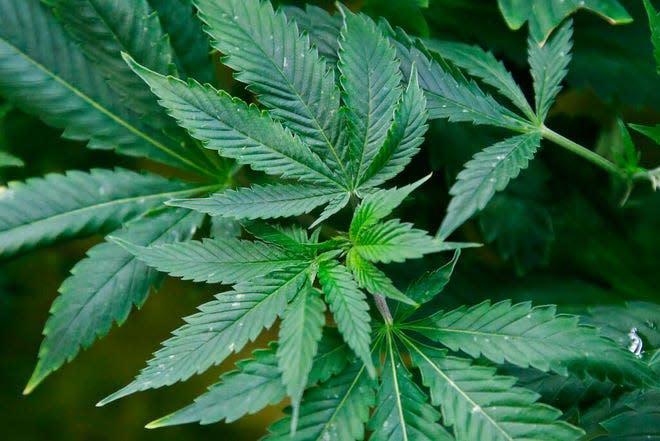Legal weed in Ohio? Here’s our analysis of Issue 2 and key points for voters to consider

It seems inevitable that Ohio will join 23 other states, including Michigan, in legalizing recreational marijuana sooner or later.
Marijuana is already widely available through street buys and its pungent odor can be hard to miss at some events across Ohio. Prosecutors rarely seek charges for people smoking joints, although trafficking laws are enforced.
Does that mean recreational marijuana should be legal? Is Ohio Issue 2 on the Nov. 7 ballot the proper law to make that happen?
Voter Guide: Information on 2023 election in Summit County and Ohio Issue 1 and 2
Our editorial board is split on this issue, with some arguing the measure legalizes current behavior and conforms with our society’s evolving acceptance of marijuana. Others are concerned it will lead to expanded use of a gateway drug, more addiction problems and more deadly traffic crashes.
Here’s our analysis.
What is Issue 2?
First, this 41-page proposal would amend Ohio’s laws, not rewrite the state constitution as is the case with Issue 1 on abortion. That’s good news if lawmakers need to tweak a section of the law someday. It’s bad if they ignore the will of voters and drastically change the law as some have promised.
Placed on the ballot by the Coalition to Regulate Marijuana Like Alcohol, Issue 2 would legalize, regulate and tax adult-use marijuana in addition to the current medical cannabis program. Those age 21 or older could possess 2.5 ounces of cannabis in any form except extract and 15 grams of extract. Public and underage use would remain illegal.
Key aspects include:
A new division of the Ohio Department of Commerce would manage rules for buying, selling, smoking and growing adult-use cannabis funded by the program.
Dispensaries would be allowed to sell a wide range of products: flower, seeds, edibles, vapes, tinctures, oils, beverages, pills and lotions among others.
A personal cannabis grower could give up to six plants to another adult as long as no money is exchanged, and the transfer is not advertised.
Products would be taxed 10% in addition to Ohio’s sales tax with revenue split among a social equity and jobs program, communities with dispensaries, an addiction fund and program costs.
Arguments for Issue 2
There’s no reason to believe Ohio would be seriously harmed by legalizing marijuana based on the experiences of many states where it’s already been legal for many years.
Ohioans would be able to buy products that are regulated and safe from being laced with deadly and addictive substances such as fentanyl. Users have no idea what’s really in drugs they purchase on the street, increasing their risk of addiction or death.
Proponents contend Issue 2 won’t change any laws governing workplace safety, driving commercial vehicles or DUI laws for drivers. And they argue crime has gone down in legalized states, giving police more time to investigate other crimes.
It’s also true that drug dealers don’t pay taxes or check IDs. With Issue 2, the Drug Enforcement Policy Center at Ohio State University estimates the state could generate $276 million to $400 million in taxes annually. It also would stop people from traveling to Michigan or other states for marijuana.
At an Issue 2 forum recently, state Rep. Casey Weinstein, D-Hudson, argued that tobacco, alcohol and vaping are more addictive than responsible adult marijuana use in many cases. The same could be said of casino and sports gambling, which are now legal in Ohio.
To many, it’s a matter of personal liberty where people should be allowed to do what they want in private. Issue 2 lessens the chance of people, especially marginalized communities, being treated as criminals for a minor offense.
Arguments against Issue 2
There’s little doubt Issue 2 would put more impaired drivers on our roads. Michigan saw nearly 40% of drivers involved in fatal crashes test positive for marijuana, and increase of about 13 percentage points, after legalizing marijuana. It’s also far more difficult for law enforcement to detect impairment.
And while marijuana is widely seen as safer than heroin and other deadly drugs, research from the Centers for Disease Control and Prevention indicates use can lead to early heart problems, early strokes and marijuana use disorder.
Some of the claims made by proponents are a bit hard to accept, especially the suggestion that Issue 2 will reduce use by minors given other states’ opposite experiences with edibles.
One can reasonably assume teens and children will still have access to marijuana either through the black market or young adults sharing or selling their legal purchases. Issue 2 won’t stop kids from using marijuana in one of its many forms.
For those who can benefit from marijuana to ease pain or help medical conditions, relief already is available through the state’s medical marijuana program.
It’s also concerning that current medical marijuana cultivators and dispensaries, the main supporters of Issue 2, will have a leg up on other businesses in selling recreational marijuana.
Education needed if Issue 2 passes
Ohio voters resoundingly defeated a marijuana legalization effort in 2015, but recent polls consistently show support of about 57%.
If Issue 2 passes, Ohio will need a major public relations campaign about many aspects of marijuana use, especially the delayed high of some edibles that might catch a driver by surprise.
Any substance that puts your under its temporary influence has some risks, many of which we accept as normal behavior.
On Nov. 7, we’ll learn whether Ohioans see marijuana in the same class as alcohol.
Election 2023: Watch forum on State Issue 2, marijuana legalization effort
This article originally appeared on Akron Beacon Journal: Issue 2 Ohio pros and cons: Should voters legalize weed?

